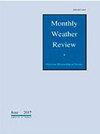Comparison of Tornado Damage Characteristics to Low-Altitude WSR-88D Radar Observations and Implications for Tornado Intensity Estimation
IF 2.8
3区 地球科学
Q3 METEOROLOGY & ATMOSPHERIC SCIENCES
引用次数: 0
Abstract
Given the obvious difficulties in directly sampling tornadic wind fields, ongoing work continues to improve estimates of near-ground wind speeds in tornadoes. This study builds upon a recently proposed empirical relationship between radar-observed velocities in the lowest 150 m AGL and the theoretical peak 15-m AGL wind speed. We create and analyze a dataset of 194 velocity observations within tornadoes in the lowest 150 m AGL. These observations are drawn from 105 individual tornadoes that occurred across a diverse range of EF-scale ratings (EF0–4), convective modes (discrete supercell and quasi-linear convective system), geographical regions, and housing-unit densities (HUD). Comparing the radar-estimated and damage-estimated tornado wind speeds, and corresponding EF- and F-scale ratings, is the primary focus of the ensuing analysis. Consistent with recent work, damage-estimated tornado wind speeds tend to be lower than radar-estimated near-surface wind speeds, especially for stronger tornadoes. Damage- and radar-estimated wind speed differences are not strongly related to the availability of damage indicators (as measured by HUD). While some relationship exists—particularly underestimates of peak wind speeds for strong–violent tornadoes in low HUD areas—the tendency of radar-based strong/violent tornado intensity estimates to be meaningfully higher than EF-scale-based damage estimates exists across the HUD spectrum. The legacy F-scale wind speed ranges may ultimately provide a better estimate of peak tornado wind speeds at 10–15 m AGL for strong–violent tornadoes and a better damage-based intensity rating for all tornadoes. These results are contextualized with regards to ongoing community efforts to improve tornado intensity estimation.龙卷风破坏特征与低空 WSR-88D 雷达观测数据的比较及对龙卷风强度估计的影响
鉴于直接采集龙卷风风场样本存在明显困难,目前仍在继续努力改进龙卷风近地风速的估算。本研究基于最近提出的最低 150 米 AGL 雷达观测速度与 15 米 AGL 理论峰值风速之间的经验关系。我们创建并分析了一个包含 194 个龙卷风中最低 150 米 AGL 速度观测值的数据集。这些观测数据来自 105 个单独的龙卷风,这些龙卷风发生在不同的 EF 等级(EF0-4)、对流模式(离散超大型龙卷风和准线性对流系统)、地理区域和住房单位密度(HUD)范围内。比较雷达估测的龙卷风风速和损害估测的龙卷风风速,以及相应的 EF 和 F 级等级是接下来分析的主要重点。与最近的研究结果一致,龙卷风的破坏估测风速往往低于雷达估测的近地面风速,特别是对于较强的龙卷风。损害估测风速和雷达估测风速之间的差异与损害指标的可用性(如 HUD 所测量的)关系不大。虽然存在一些关系--特别是低 HUD 地区的强龙卷风的峰值风速被低估,但基于雷达的强/暴力龙卷风强度估计值明显高于基于 EF 等级的损害估计值的趋势存在于整个 HUD 范围内。传统的 F 级风速范围最终可能会更好地估算出强暴力龙卷风在 10-15 米高度时的峰值风速,并更好地估算出所有龙卷风的破坏强度等级。这些结果与社区正在进行的改进龙卷风强度估算的努力有关。
本文章由计算机程序翻译,如有差异,请以英文原文为准。
求助全文
约1分钟内获得全文
求助全文
来源期刊

Monthly Weather Review
地学-气象与大气科学
CiteScore
6.40
自引率
12.50%
发文量
186
审稿时长
3-6 weeks
期刊介绍:
Monthly Weather Review (MWR) (ISSN: 0027-0644; eISSN: 1520-0493) publishes research relevant to the analysis and prediction of observed atmospheric circulations and physics, including technique development, data assimilation, model validation, and relevant case studies. This research includes numerical and data assimilation techniques that apply to the atmosphere and/or ocean environments. MWR also addresses phenomena having seasonal and subseasonal time scales.
文献相关原料
| 公司名称 | 产品信息 | 采购帮参考价格 |
|---|
 求助内容:
求助内容: 应助结果提醒方式:
应助结果提醒方式:


